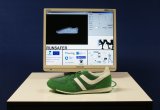New high-tech shoe to revolutionize running training
A prototype running shoe that would significantly improve running training is to be developed as part of the »RUNSAFER« project launched in September 2012. A total of seven representatives from the worlds of research and industry are involved in this EU-funded project. The aim is to support runners to monitor their training effectively with a novel technical system solution that goes beyond the mere measurement of vital parameters. Compared with other commercially available running monitors, this system will be the first on the market capable of characterizing a person's running technique based on biomechanical variables and will provide runners with real-time recommendations during their training workout. In this way it is hoped that running injuries can be avoided at an early stage.
Running is becoming more and more popular and is now one of the most widespread types of endurance sport in Europe. Although running is considered to be particularly healthy, the number of running injuries is growing steadily. The reasons for this are diverse and vary from runner to runner. Often these are not serious injuries that paralyze an athlete but are rather symptoms of overloading. Especially runners who start off without warming-up or expect too much from themselves are very susceptible to injuries. Injuries can range from cramps and sore muscles, to knee pain and torn tendons and even pulled muscles, over-extensions and, in the worst case, torn ligaments.
Alongside the Fraunhofer Institute for Photonic Microsystems, six other partners are working on the EU »RUNSAFER« project to ensure improved monitoring of training to counter injuries during workouts. The main focus of this work is the development of a special prototype running shoe, in which a micro-electronic system is integrated to measure the athlete's biomechanical data while he is running and thus analyze his running technique in real-time. Popular running monitors currently only enable vital parameters, like heart rate or pulse, to be measured. By contrast, the newly developed system is intended to enable the measurement and evaluation of the athlete's running technique and warn him if it detects an incorrect foot position or overloading. The readings are transmitted wirelessly to the runner's mobile phone, where a corresponding app provides feedback on current training performance in real-time. In addition, the app also suggests modifications to the runner's motion pattern, preventing loading on one side and resulting injuries. The readings are transmitted to a web-based portal for post-processing and further analysis during the actual training session. Improvements to training techniques can be followed up based on this analysis and personalized training plans created. The global networking of athletes on social networks is also possible.
Fulfilling the above requirements requires a sophisticated system that will deliver ultra-precise readings and that is durable, lightweight and comfortable to wear. Price also plays a key role in ensuring that this innovation catches on. Translating these considerations into a coherent system is the task of the Fraunhofer IPMS, which is responsible both for the development of the micro-system and for the energy supply to the shoe and wireless transmission of the readings. »The development of the system per se is based on technical sensors,« explains Dr. Andreas Heinig from the Wireless Microsystems division and continues: »Using built-in sensors for acceleration and rate of rotation, the system integrated in the shoe will be capable of recording comprehensive measurements of the athlete's running technique. These readings will be transmitted by radio to the runner's mobile phone and will then be translated into parameters by means a special algorithm, to make them available for immediate monitoring and analysis of training.«
The RUNSAFER project (Grant Agreement No. 285800) is financed by the European Commissions' special funding tool, the »Research for the Benefit for SMEs«, as part of its 7th Research Framework Programme (FP7). In addition to the Fraunhofer IPMS, the EII (Estonian Innovation Institute) and the IBV (Institute of Biomechanics in Valencia) which are involved in the project as further research institutions, the companies Kelme (Spain), Dukosi (United Kingdom) and Nuromedia (Germany) are also partners in the project.
About Fraunhofer IPMS
The Fraunhofer Institute for Photonic Microsystems IPMS and its 200 employees turn over an annual research volume of 20 million euros. Fraunhofer IPMS generates more than two thirds of this production capacity out of commissions from industry and publicly financed projects in applied research. The focus of our development and production services lies in the practical industrial application of unique technological know-how in the fields of (optical) micro-electromechanical systems [MEMS, MOEMS]. Fraunhofer IMPS uses scientific know-how, application experience and customer contacts as well as modern equipment and clean room infrastructure. Fraunhofer IPMS covers a broad spectrum of industrial applications. Our services range from initial conception to product development, right down to serial pilot production – from a single component to a complete system solution.
 Fraunhofer Institute for Photonic Microsystems
Fraunhofer Institute for Photonic Microsystems